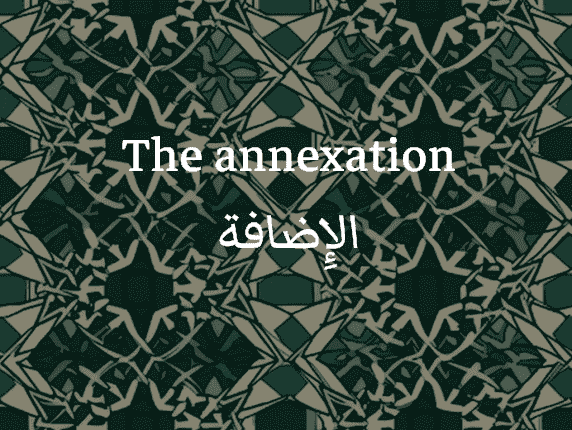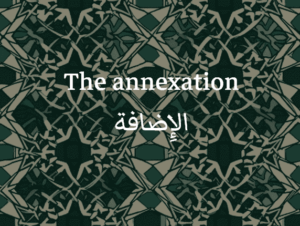The annexation / الإِضافة

The concept of annexation in Arabic is called إِضافة (iḍāfa) in the Arabic language expresses the idea of two nouns (or an adjective and a noun) linked together and immediately following each other. This is similar to an attributive formation, where the main noun comes first and serves as the head constituent while the second noun is the attribute.
Each annexation is composed of a 1st term (المُضاف) “the annexed” which is completed by a 2nd term (المُضاف إِليه) “the annexer”, without the need for a preposition.
Rules concerning the annexation / أحْكام الإِضافة
- Regardless of whether the 1st term is definite or indefinite, it never takes the definite article ال /al/ nor does it get ‘nunated’ (التَنْوِين).
- The 2nd term (the annexer) will always be in the genitive case and may or may not feature ال /al/ or nunation depending on its definite status.
- When the 2nd (the annexer) is written in definite form, it renders the entire iḍāfa structure definite; however, if its form is indefinite, then the whole iḍāfa becomes indefinite as well.
The first type: the genuine annexation / الإِضافة الحَقِيقِيّة
- It corresponds to the genitive construction and is similar to English ‘of …’ or ‘…’s’.
- It can express the relation between an item and a material.
| Definite form (المَعْرِفة) | Indefinite form (النَكِرة) | |
|---|---|---|
| قَصْرُ المَلِكِ The king’s castle | قَصْرُ مَلِكٍ A king’s castle | 1. |
| وَزيرُ البَلَدِ The minister of the country | وَزيرُ بَلَدٍ A country’s minister | 1. |
| كُرْسيُّ الخَشَبِ The wooden seat | كُرْسيُّ خَشَبٍ A wooden seat | 2. |
The second type: the adjectival annexation / الإِضافة المَجازِيّة
The second structure of iḍāfa is sometimes referred to as the ‘iḍāfa adjective’ since an adjective is combined with a definite noun (اِسْم مَعْرِفة) in the genitive case (مَجْرور). This type of construction, known as الإِضافة المَجازِيّة which roughly translates to “metaphorical annexation” in English, expresses something about the quality expressed by the adjective and its corresponding noun. To make it simpler we can summarize this type of annexation as being an adjective followed by its complement.
| Fast learning | سَريعُ التَّعَلُّمِ |
| Insolent (lit. one with a long tongue) | طَوِيلُ اللِّسانِ |
| Impatient (lit. little in patience) | قَلِيلُ الصَبْرِ |
Dual and plural in the annexation / الجَمْع والمُثَنّى في الإِضافة
Dual / المُثَنَّى
The final syllable نِ…/… ni/ of the dual masculine and feminine disappears when the noun is defined by a complement (iḍāfa construction):
| Defined by complement (iḍāfa) | Indefinite or definite with article | Noun case |
|---|---|---|
| مُعَلِّما المَدْرَسةِ the two teachers of the school | مُعَلِّمانِ ←) المُعَلِّمانِ) the two teachers | Nominative (مَرْفٌوع) |
| مُعَلِّمَيِ المَدْرَسةِ the two teachers of the school | مُعَلِّمَينِ ←) المُعَلِّمَينِ) the two teachers | Accusative and genitive (مَنْصُوب ومَجْرور) |
Sound plural / الجَمْع السالِم
Whenever the noun is defined by a complement (iḍāfa construction)
The ن of the sound plural masculine disappears, as in the dual form. This is only applicable to sound plurals and not broken plurals.
| Defined by a complement (iḍāfa) | Defined by article or indefinite | Noun case |
|---|---|---|
| مُعَلِّمُو المَدْرَسةِ the school teachers | مُعَلِّمُونَ ←) المُعَلِّمُونَ) the teachers | Nominative (مَرْفٌوع) |
| مُعَلِّمِي المَدْرَسةِ the school teachers | مُعَلِّمِينَ ←) المُعَلِّمِينَ) the teachers | Accusative and genitive (مَنْصُوب ومَجْرور) |
The Annexation

Learn all about the essential grammatical concept of the annexation in Arabic and how to use it correctly.
Course Provider: Organization
Course Provider Name: ArabiKey
Course Provider URL: https://arabikey.com
5

Responses